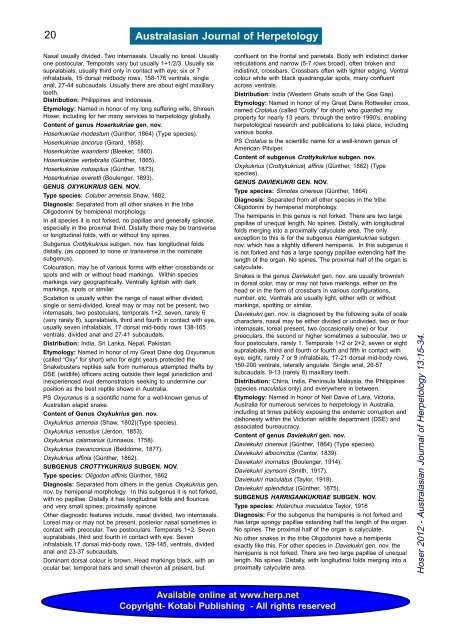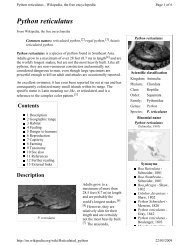Issue Thirteen 30 June 2012 - Taxonomic issue - all - Smuggled.com
Issue Thirteen 30 June 2012 - Taxonomic issue - all - Smuggled.com
Issue Thirteen 30 June 2012 - Taxonomic issue - all - Smuggled.com
Create successful ePaper yourself
Turn your PDF publications into a flip-book with our unique Google optimized e-Paper software.
20<br />
Nasal usu<strong>all</strong>y divided. Two internasals. Usu<strong>all</strong>y no loreal. Usu<strong>all</strong>y<br />
one postocular, Temporals vary but usu<strong>all</strong>y 1+1/2/3. Usu<strong>all</strong>y six<br />
supralabials, usu<strong>all</strong>y third only in contact with eye; six or 7<br />
infralabials, 15 dorsal midbody rows, 158-176 ventrals, single<br />
anal, 27-44 subcaudals. Usu<strong>all</strong>y there are about eight maxillary<br />
teeth.<br />
Distribution: Philippines and Indonesia.<br />
Etymology: Named in honor of my long suffering wife, Shireen<br />
Hoser, including for her many services to herpetology glob<strong>all</strong>y.<br />
Content of genus Hoserkukriae gen. nov.<br />
Hoserkukriae modestum (Günther, 1864) (Type species).<br />
Hoserkukriae ancorus (Girard, 1858).<br />
Hoserkukriae waandersi (Bleeker, 1860).<br />
Hoserkukriae vertebralis (Günther, 1865).<br />
Hoserkukriae notospilus (Günther, 1873).<br />
Hoserkukriae everetti (Boulenger, 1893).<br />
GENUS OXYKUKRIUS GEN. NOV.<br />
Type species: Coluber arnensis Shaw, 1802.<br />
Diagnosis: Separated from <strong>all</strong> other snakes in the tribe<br />
Oligodonini by hemipenal morphology.<br />
In <strong>all</strong> species it is not forked, no papillae and gener<strong>all</strong>y spinose,<br />
especi<strong>all</strong>y in the proximal third. Dist<strong>all</strong>y there may be transverse<br />
or longitudinal folds, with or without tiny spines.<br />
Subgenus Crottykukrius subgen. nov. has longitudinal folds<br />
dist<strong>all</strong>y, (as opposed to none or transverse in the nominate<br />
subgenus).<br />
Colouration, may be of various forms with either crossbands or<br />
spots and with or without head markings. Within species<br />
markings vary geographic<strong>all</strong>y. Ventr<strong>all</strong>y lightish with dark<br />
markings, spots or similar.<br />
Scalation is usu<strong>all</strong>y within the range of nasal either divided,<br />
single or semi-divided, loreal may or may not be present, two<br />
internasals, two postoculars, temporals 1+2, seven, rarely 6<br />
(very rarely 8), supralabials, third and fourth in contact with eye,<br />
usu<strong>all</strong>y seven infralabials. 17 dorsal mid-body rows 138-165<br />
ventrals, divided anal and 27-41 subcaudals.<br />
Distribution: India, Sri Lanka, Nepal, Pakistan.<br />
Etymology: Named in honor of my Great Dane dog Oxyuranus<br />
(c<strong>all</strong>ed “Oxy” for short) who for eight years protected the<br />
Snakebusters reptiles safe from numerous attempted thefts by<br />
DSE (wildlife) officers acting outside their legal jurisdiction and<br />
inexperienced rival demonstrators seeking to undermine our<br />
position as the best reptile shows in Australia.<br />
PS Oxyuranus is a scientific name for a well-known genus of<br />
Australian elapid snake.<br />
Content of Genus Oxykukrius gen. nov.<br />
Oxykukrius arnensis (Shaw, 1802)(Type species).<br />
Oxykukrius venustus (Jerdon, 1853).<br />
Oxykukrius calamarius (Linnaeus, 1758).<br />
Oxykukrius travancoricus (Beddome, 1877).<br />
Oxykukrius affinis (Günther, 1862).<br />
SUBGENUS CROTTYKUKRIUS SUBGEN. NOV.<br />
Type species: Oligodon affinis Günther, 1862<br />
Diagnosis: Separated from others in the genus Oxykukrius gen.<br />
nov. by hemipenal morphology. In this subgenus it is not forked,<br />
with no papillae. Dist<strong>all</strong>y it has longitudinal folds and flounces<br />
and very sm<strong>all</strong> spines; proxim<strong>all</strong>y spinose.<br />
Other diagnostic features include, nasal divided, two internasals.<br />
Loreal may or may not be present, posterior nasal sometimes in<br />
contact with preocular. Two postoculars. Temporals 1+2. Seven<br />
supralabials, third and fourth in contact with eye. Seven<br />
infralabials.17 dorsal mid-body rows, 129-145, ventrals, divided<br />
anal and 23-37 subcaudals.<br />
Dominant dorsal colour is brown. Head markings black, with an<br />
ocular bar, temporal bars and sm<strong>all</strong> chevron <strong>all</strong> present, but<br />
Australasian Journal of Herpetology<br />
confluent on the frontal and parietals. Body with indistinct darker<br />
reticulations and narrow (5-7 rows broad), often broken and<br />
indistinct, crossbars. Crossbars often with lighter edging. Ventral<br />
colour white with black quadrangular spots, many confluent<br />
across ventrals.<br />
Distribution: India (Western Ghats south of the Goa Gap).<br />
Etymology: Named in honor of my Great Dane Rottweiler cross,<br />
named Crotalus (c<strong>all</strong>ed “Crotty” for short) who guarded my<br />
property for nearly 13 years, through the entire 1990’s, enabling<br />
herpetological research and publications to take place, including<br />
various books.<br />
PS Crotalus is the scientific name for a well-known genus of<br />
American Pitviper.<br />
Content of subgenus Crottykukrius subgen. nov.<br />
Oxykukrius (Crottykukrius) affinis (Günther, 1862) (Type<br />
species).<br />
GENUS DAVIEKUKRI GEN. NOV.<br />
Type species: Simotes cinereus (Günther, 1864)<br />
Diagnosis: Separated from <strong>all</strong> other species in the tribe<br />
Oligodonini by hemipenal morphology.<br />
The hemipenis in this genus is not forked. There are two large<br />
papillae of unequal length. No spines. Dist<strong>all</strong>y, with longitudinal<br />
folds merging into a proxim<strong>all</strong>y calyculate area. The only<br />
exception to this is for the subgenus Harrigankukriae subgen.<br />
nov. which has a slightly different hemipenis. In this subgenus it<br />
is not forked and has a large spongy papillae extending half the<br />
length of the organ. No spines. The proximal half of the organ is<br />
calyculate.<br />
Snakes is the genus Daviekukri gen. nov. are usu<strong>all</strong>y brownish<br />
in dorsal color, may or may not have markings, either on the<br />
head or in the form of crossbars in various configurations,<br />
number, etc. Ventrals are usu<strong>all</strong>y light, either with or without<br />
markings, spotting or similar.<br />
Daviekukri gen. nov. is diagnosed by the following suite of scale<br />
characters, nasal may be either divided or undivided, two or four<br />
internasals, loreal present, two (occasion<strong>all</strong>y one) or four<br />
preoculars, the second or higher sometimes a subocular, two or<br />
four postoculars, rarely 1. Temporals 1+2 or 2+2, seven or eight<br />
supralabials, third and fourth or fourth and fifth in contact with<br />
eye, eight, rarely 7 or 9 infralabials, 17-21 dorsal mid-body rows,<br />
150-200 ventrals, later<strong>all</strong>y angulate. Single anal, 26-57<br />
subcaudals. 9-13 (rarely 8) maxillary teeth.<br />
Distribution: China, India, Peninsula Malaysia, the Philippines<br />
(species maculatus only) and everywhere in between.<br />
Etymology: Named in honor of Neil Davie of Lara, Victoria,<br />
Australia for numerous services to herpetology in Australia,<br />
including at times publicly exposing the endemic corruption and<br />
dishonesty within the Victorian wildlife department (DSE) and<br />
associated bureaucracy.<br />
Content of genus Daviekukri gen. nov.<br />
Daviekukri cinereus (Günther, 1864) (Type species).<br />
Daviekukri albocinctus (Cantor, 1839).<br />
Daviekukri inornatus (Boulenger, 1914).<br />
Daviekukri joynsoni (Smith, 1917).<br />
Daviekukri maculatus (Taylor, 1918).<br />
Daviekukri splendidus (Günther, 1875).<br />
SUBGENUS HARRIGANKUKRIAE SUBGEN. NOV.<br />
Type species: Holarchus maculatus Taylor, 1918<br />
Diagnosis: For the subgenus the hemipenis is not forked and<br />
has large spongy papillae extending half the length of the organ.<br />
No spines. The proximal half of the organ is calyculate.<br />
No other snakes in the tribe Oligodonini have a hemipenis<br />
exactly like this. For other species in Daviekukri gen. nov. the<br />
hemipenis is not forked. There are two large papillae of unequal<br />
length. No spines. Dist<strong>all</strong>y, with longitudinal folds merging into a<br />
proxim<strong>all</strong>y calyculate area.<br />
Available online at www.herp.net<br />
Copyright- Kotabi Publishing - All rights reserved<br />
Hoser <strong>2012</strong> - Australasian Journal of Herpetology 13:15-34.



